Siddhi Lakshmi (Purnachandi)
Nepal ca. 16th–17th centurySiddhi Lakshmi (Purnachandi); Nepal; ca. 16th–17th century; gilt bronze with pigment; height: 15 ¾ in. (40 cm); Patan Museum, Patan, Nepal; object 234; photograph by Erik Törner
The Goddess of Miraculous Power
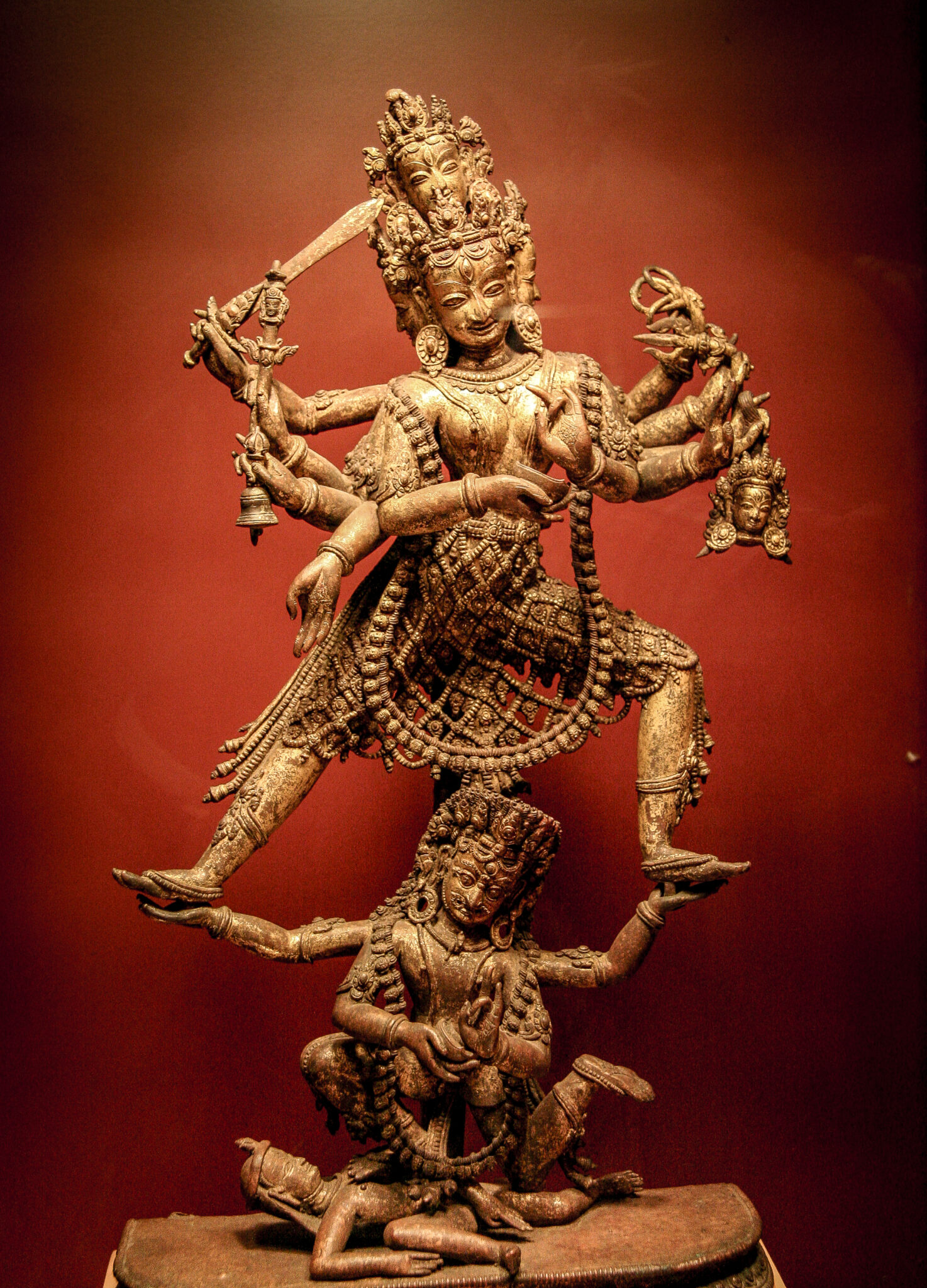
Siddhi Lakshmi (Purnachandi); Nepal; ca. 16th–17th century; gilt bronze with pigment; height: 15 ¾ in. (40 cm); Patan Museum, Patan, Nepal; object 234; photograph by Erik Törner
Siddhi Lakshmi (Purnachandi); Nepal; ca. 16th–17th century; gilt bronze with pigment; height: 15 ¾ in. (40 cm); Patan Museum, Patan, Nepal; object 234; photograph by Erik Törner
Indic religions often emphasize the spiritual energy (shakti) of female deities, whether wrathful or benign. Art historian Kerry Lucinda Brown introduces this dynamic bronze sculpture of a powerful tantric goddess Siddhi Lakshmi. She is associated with other Indic goddesses, Mahadevi and Kali. Rival kings in city-states of Kathmandu, Patan, and Bakhtapur used to worship her in secret, and both Hindus and Buddhists celebrate her public images at shrines and festivals.
Hinduism is a collection of religious beliefs and practices comprising a major Asian religion, practiced principally on the Indian Subcontinent and parts of Southeast Asia. Although certain practices may have their roots in the ancient Indus Valley civilization (~3300–1300 BCE), the earliest decipherable texts of Hinduism are the Vedas, ritual-mythological hymns and instructions for fire-sacrifice from around 1500–900 BCE. From around 800 to 300 BCE, new thinkers emphasized philosophical ideas like ritual union with the deity Brahman, or meditation and asceticism in the forest. One of these thinkers was Siddhartha Gautama, the founding teacher of Buddhism. Hindu temples appeared from the medieval period onward, dedicated to gods like Brahma, Vishnu, Shiva, and Mahadevi. There are also tantric forms of Hinduism, which emphasize transgressive practices and yogic ritual.
The Malla dynasty ruled the Kathmandu Valley in central Nepal from the early thirteenth century until 1769. For most of this period, there was not one single Malla ruler; rather, different branches of the Malla family formed a Newar-speaking noble class that ruled the three city-states of Kathmandu, Bakhtapur, and Patan. Due to the cultural competition between these cities and courts, the Malla period is remembered as a great age of Hindu and Buddhist art and architecture in Nepal. The Malla period came to an end when the Gorkha ruler Prithvi Narayan Shah (1723–1775) conquered the area of present-day Nepal. (The Malla dynasty is not to be confused with the Khasa Malla.)
In Hinduism, the matrikas are a group of fierce goddesses, each of whom is associated with a mantra seed syllable. These goddesses are often thought of as the female energies (Skt. shakti) of particular male gods. There are usually said to be seven matrikas, corresponding to the seven stars of the Pleiades. In Nepal there are understood to be eight matrikas: Brahmani, Vaishnavi, Maheshwari, Indrani, Kaumari, Varahi, Chamunda, and Mahalakshmi.
The Newars are traditional inhabitants of the Kathmandu Valley of Nepal. The Newars speak a Tibeto-Burman language (Newari) and practice both Hinduism and Buddhism. The Newars are inheritors of one of the oldest and most sophisticated urban civilizations of the Himalayas, and Newar arts and artisans have been celebrated all across the Himalayan world since the Licchavi period.
In Hinduism, a pitha is a sacred place, generally a shrine where an image or emblem of a deity is worshiped. Pithas are especially associated with goddess worship, either of Sati/Parvati (the wife of Shiva), or of other forms of shakti, the divine female energy.
Tantra was a religious movement in India around the fifth to seventh centuries, and its practices are part of Buddhism and Hinduism. The word tantra also refers to texts which transmit tantric practices. In Buddhism, tantra is also called Vajrayana, “The Vajra Vehicle.” Tantric ritual and art are characterized by deity yoga, mandalas, mantras, abhisheka (initiation), wrathful deities, and ritual sexual union. In Hinduism, tantrism was often associated with the worship of Shiva and various goddesses (shakti). A practitioner of tantra is called a “tantrika.” Tantra is also a genre of texts that have been variously categorized. Most common is the division of tantras into four categories: Kriya Tantra, Charya Tantra, Yoga Tantra, and Highest Yoga Tantra.
In Hinduism, Shakti is the divine female power, considered to be the active, creating agent in the power of the gods. Goddesses like Mahadevi, Kali, Durga, and Parvati are all considered to be aspects of this fundamental force. The traditions that worship these goddesses are called “Shaktism,” and a devotee is called a “Shakta.”
In Hinduism, Mahadevi is the great goddess, the ultimate form of shakti, or the divine female energy. Worshippers of Mahadevi, called “shaktas,” consider her a creator deity equivalent to “Brahman,” or the fundamental basis of reality. Different Hindu traditions consider Kali, Durga, Lakshmi, Parvati, Sarasvati, and all other Hindu goddesses to be aspects of Mahadevi.
Goddesses play a vital role in establishing sacred geography and reaffirming the power of the rulers and kingdoms they protect. One of the most powerful tantric goddesses in the Kathmandu Valley is Siddhi , also known by her local name, Purnachandi. She is a secret form of Taleju, the tutelary goddess for the royal families of the (ca. 1200–1769) and the self-chosen goddess (ishtadevata) of the king. After the death of King Yaksha Malla (r. 1428–1482) in the fifteenth century, the kingdom fractured into three parts. In what is now known as the Three Kingdoms period (1482–1769), royal power was divided among the cities of Kathmandu, Patan (Lalitpur), and Bhaktapur. Rivalries between rulers for political and religious authority led to intense building campaigns that resulted in capital cities filled with elaborate palace complexes, temples dedicated to Buddhist and Hindu deities, and large public squares for communal celebrations. The rulers of the Three Kingdoms period used tantric systems to organize their kingdoms, with royal palaces and protective deities situated in the center of each kingdom. Within this contentious environment, Siddhi Lakshmi emerged as a powerful, yet secret tantric deity for the Malla kings.
Locations of Bhaktapur, Kathmandu, and Patan in the Kathmandu Valley
The veneration of Siddhi Lakshmi is part of a larger tantric system referred to as Sarvamnaya and is associated with the Secret Black Mother () . She encompasses the totality of all the goddesses and their collective spiritual energy (shakti). As such, she is a manifestation of the supreme great goddess, . Furthermore, the association with Taleju connects Siddhi Lakshmi with the Hindu goddess (fig. 3), one of the most popular public goddesses of the Hindu pantheon. Siddhi Lakshmi is worshipped to destroy evil, repel negative forces, cultivate wisdom, and provide material and spiritual success. With these powers, it is no wonder she became one of the primary tantric deities venerated by the Malla kings.
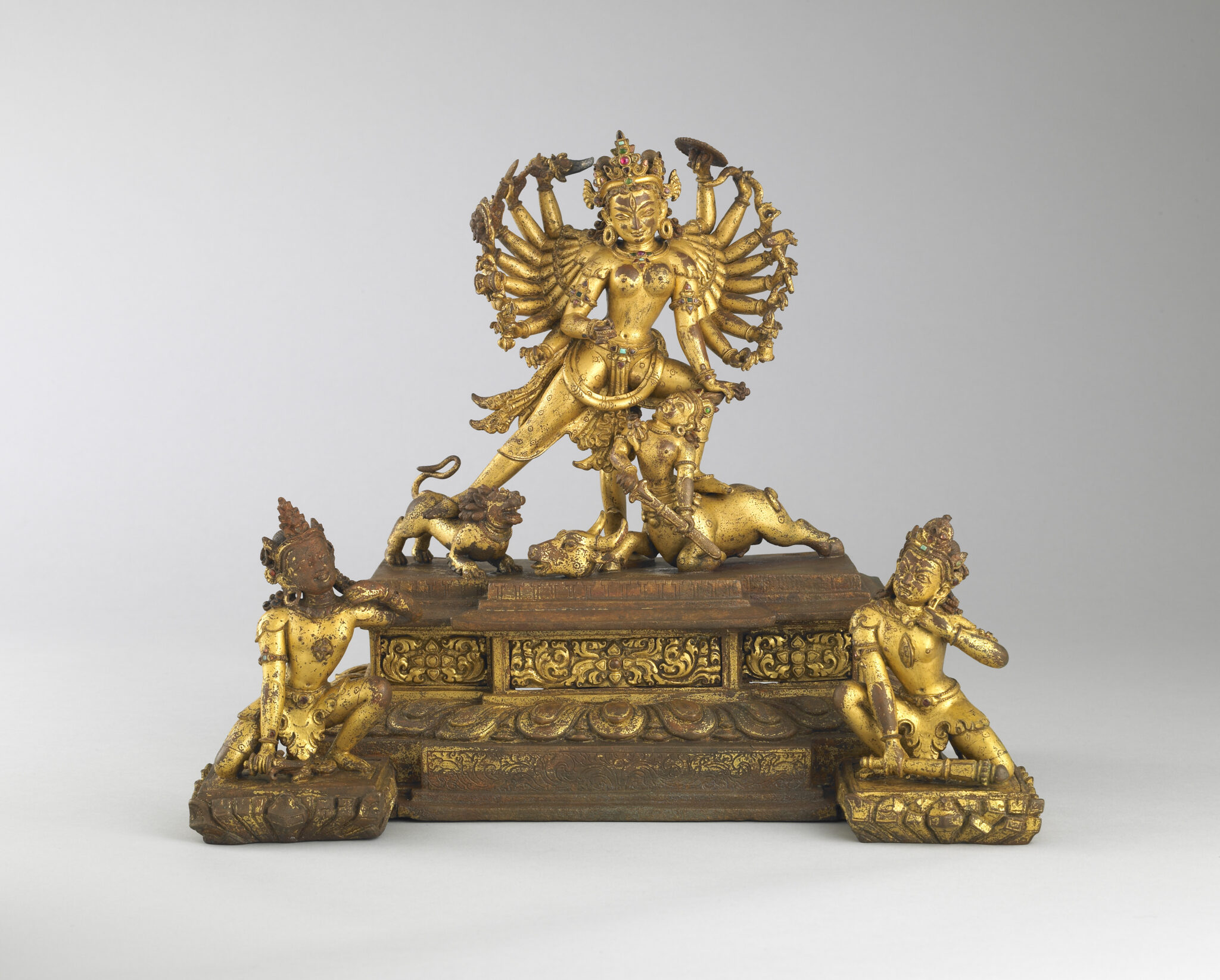
Durga Killing the Buffalo Demon (Durga Mahishasuramardini); Nepal; 12th–13th century; gilt-copper alloy; 11 × 13 1/8 × 7½ in. (27.9 × 33.3 × 19.1 cm); Rubin Museum of Art; C2005.16.11
Dated to the sixteenth or seventeenth century, the gilt-bronze image of Siddhi Lakshmi in the collection of the Patan Museum serves as one of the finest examples of Newar lost-wax casting from the Three Kingdoms Period. The delicate modeling of the form makes it easy to understand why Newar artists were highly prized by Tibetan and patrons. The stacked composition of the image establishes a clear visual hierarchy and reinforces the power and ritual authority of the goddess. Siddhi Lakshmi is positioned in an aggressive standing posture (alidha sthana), with her left leg bent and the right stretched to the side. She balances on the outstretched arms of , a form of the Hindu god , whose palms support the feet of the goddess. Bhairava is in a kneeling posture astride a corpse that is splayed across the lotus pedestal base. The dynamic postures of the figures animate the form and enliven the deities, setting this piece apart from other depictions of Siddhi Lakshmi with static compositions (fig. 4).
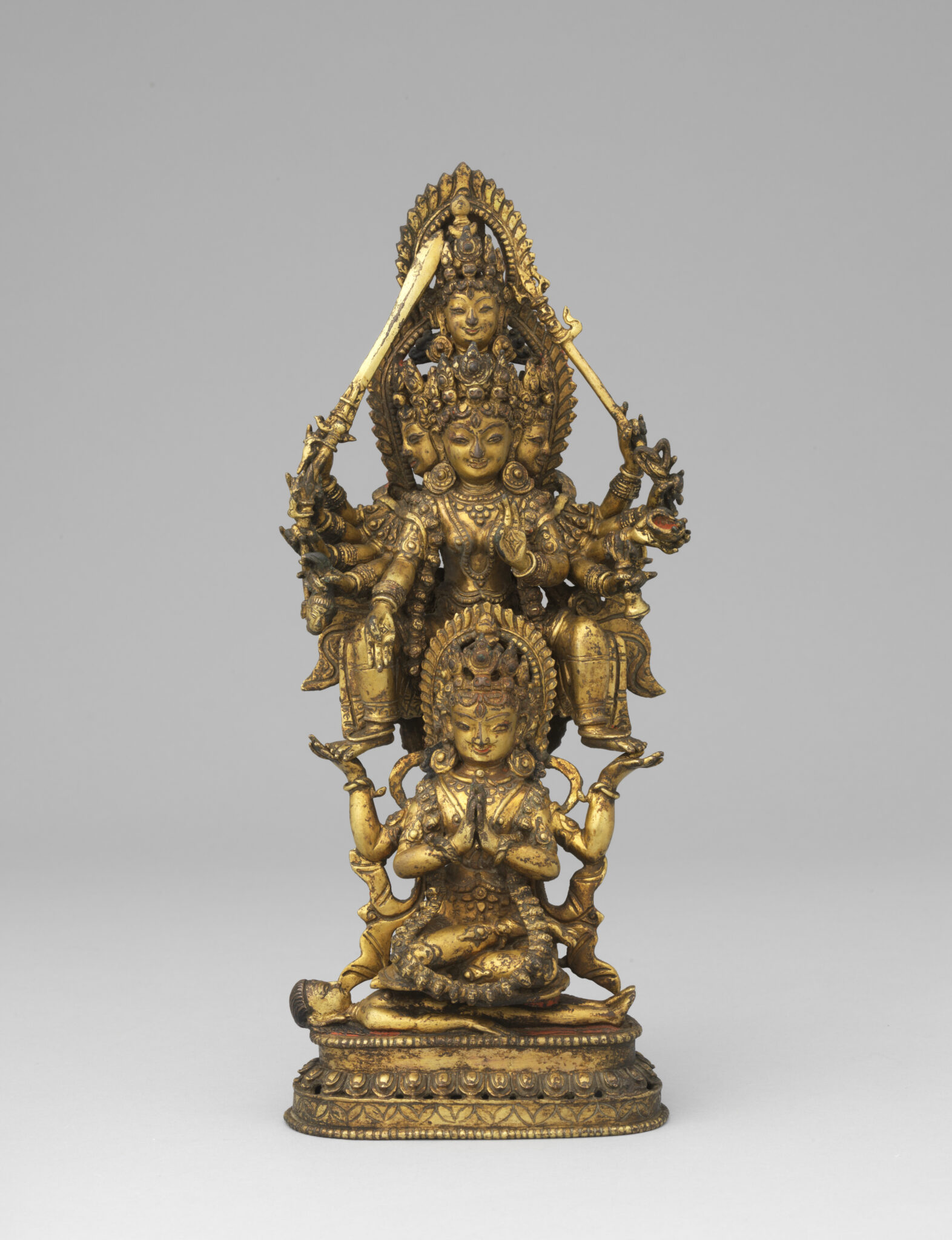
Siddhi Lakshmi; Nepal; 17th century; giltcopper alloy; 10¾ × 4¾ × 5-7/8 in. (27.3 × 12.1 × 14.9 cm); Rubin Museum of Art; C2004.34.4 (HAR 65402)
As the largest figure in the composition, Siddhi communicates a complex visual narrative that affirms her ability to bestow unwavering success and accomplishment. Each of her five heads has a third eye and wears a crown with skull ornaments and foliate motifs (fig. 5). While classified as dangerous and bloodthirsty, Siddhi Lakshmi has a sweetly smiling face, a stylistic feature typical in Newar art. The hand gestures () and attributes displayed in her ten arms reinforce her ability to protect and grant power. As part of her wrathful nature, she wears a bone apron and necklace of severed skulls, similar to the ritual regalia worn by the goddess . Each set of five arms delicately extends from the shoulders, with each arm gracefully arranged around the torso. While holding a skull cup to her chest with her central right hand, her left hand makes the sprinkling gesture (bindukapala mudra), signifying the transmission of spiritual power to the practitioner. From top to bottom, her remaining right hands display a sword, a staff, and a bell, with the last hand outstretched in the gesture of giving (varada mudra), reinforcing her ability to bestow power. Her remaining left hands hold a noose, a trident, and a freshly severed head, with the lowest hand presenting the fear-not gesture (abhaya mudra). Together, these features reiterate her ability to overcome obstacles, wield power, and protect the faithful.
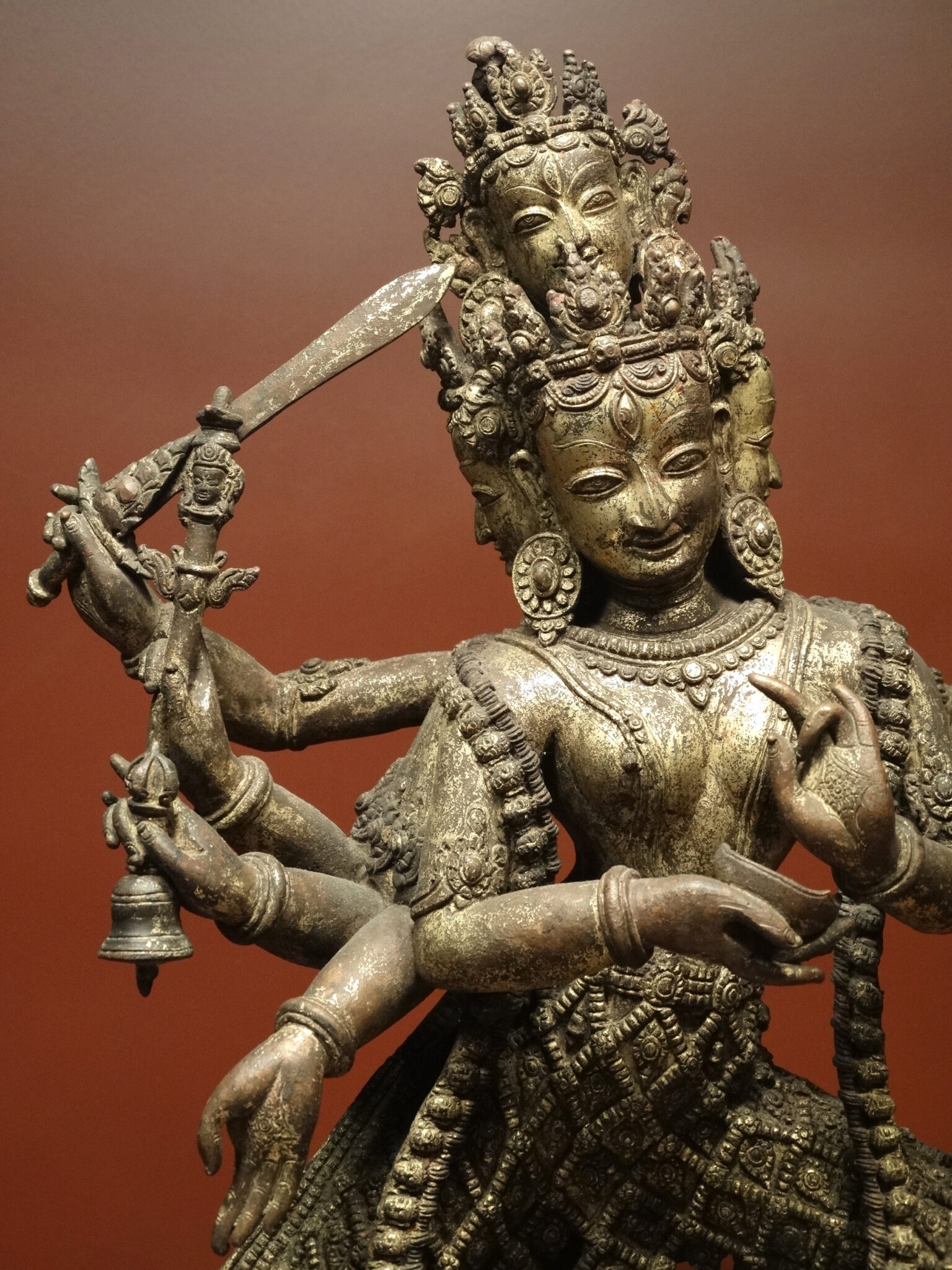
Bhairava is shown as subordinate to the goddess, yet also subjugating the corpse below his feet. He plays an important role in this visual narrative, as he literally supports and sustains the goddess above. His upper arms extend to bear the goddess, whose feet rest in his hands. Mirroring the goddess above, Bhairava stands in an aggressive stance, wears a necklace of skulls, holds a skull cup, and conveys the gesture of sprinkling (bindukapala mudra). His large eyes, fangs, mustache, flaming hair, and snake ornaments reaffirm his wrathful nature. The visual harmony of these two figures strengthens the overall visual narrative and reinforces the relationship between the deities. Here the male-female dichotomy in is expressed by a delicate balance of male and female principles, yet the visual hierarchy asserts the dominance of the feminine divine. This union expresses the duality of these principles in Nepalese tantric systems. The exalted status of Siddhi Lakshimi among the Malla kings is rooted in the notion that she embodies the collective spiritual energy (shakti) of all goddesses, thus she wields the combined power of all sacred abodes (tirtha) and seats () of the greater Kathmandu Valley.
The array of surviving paintings and sculptures of Siddhi Lakshmi suggests her veneration was popular among the royal elites and possibly extended beyond this circle to other tantric initiates. In , the word siddhi can mean accomplishment, knowledge, or attainment. As the supreme goddess of miraculous accomplishment, Siddhi Lakshmi was venerated by the kings of Nepal to protect their throne, their ritual authority, and their kingdom.
In the city of Patan, Siddhi Narasimha Malla (r. 1619–1661) consecrated the Purnachandi Temple in 1635 (fig. 6). The temple is the center of mother goddess () veneration in Patan. The main shrine and flanking deities at the Purnachandi shrine consist of river stones (dhunga) which identifies this site as the naturally arisen seat of the goddess (shakti pitha) (fig. 7). She is venerated by both Buddhists and Hindus, demonstrating the importance of the goddess to Newar culture. Various rites and celebrations honor Purnachandi, including an annual pilgrimage () to the eight shakti pitha of (fig. 8). This pilgrimage begins with the worship of all the goddesses in the courtyard in front of the Purnachandi Temple, followed by a daylong journey around Patan making offerings at each shaki pitha, culminating in a final communal offering back in front of the Purnachandi Temple. As a tantric goddess, she receives meat and alcohol offerings from participants (fig. 9). The popularity of these types of localized pilgrimage traditions in the Kathmandu Valley today speaks to the importance of the goddess traditions in contemporary practice. More important, this temple and the community rituals supported by the community provide opportunities for the public to gain access to the secret goddess, Siddhi Lakshmi, through the veneration of Purnachandi. Annual celebrations such as these reaffirm community support for the goddess and root these ritual systems in each new generation, affording Newar culture a tremendous amount of cultural continuity with each passing century.

Purnachandi Temple, consecrated during the reign of Siddhi Narasimha Malla; Patan, Nepal; 1635; photograph © Kerry Lucinda Brown
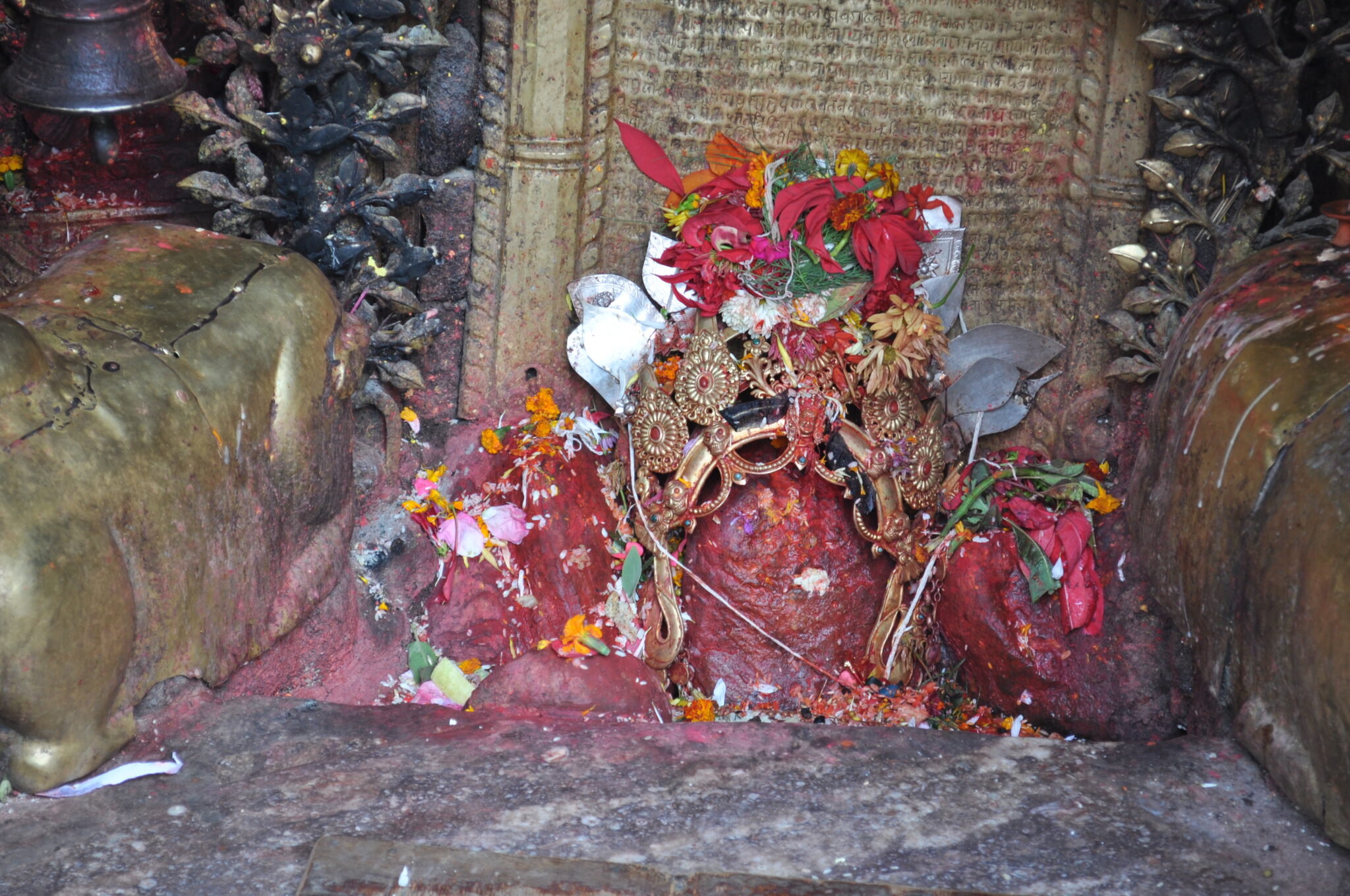
Detail of the crowned dhunga within the Purnachandi Temple, located to the left of the central shrine; Patan, Nepal; 2010; photograph © Kerry Lucinda Brown

Modern print reproductions of the goddess, with offering mandalas prepared before the start of the pilgrimage; Purnachandi Temple, Patan, Nepal; 2010; photograph © Kerry Lucinda Brown
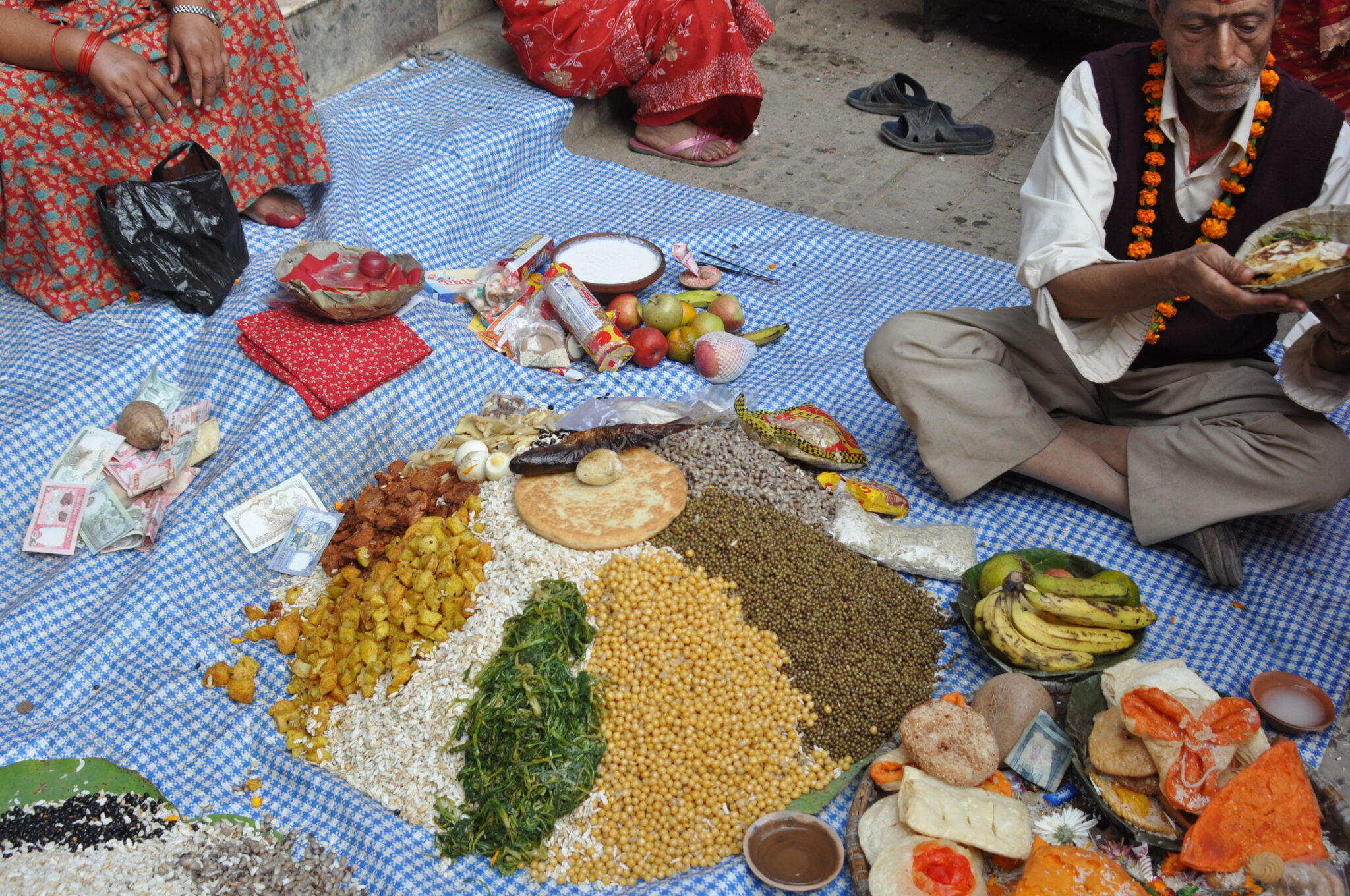
At the completion of the shakti pitha pilgrimage honoring the eight mother goddesses, a large offering is made in front of the Purnachandi Temple containing meat and alcohol offerings, as is typical with tantric deities; Patan, Nepal; 2010; photograph © Kerry Lucinda Brown
For the Malla kings of Patan, the esoteric forms of this goddess, whether called Purnachandi, Siddhi Lakshmi, or Taleju, were important in validating their divine right to rule. Subsequent kings of Patan built elaborate temples to reaffirm the importance of goddess veneration to the kingdom. The Degutale Temple, built in 1661, and the grand multistory Taleju Temple, built in 1667 as part of the Patan Royal Palace, reiterate the central importance of these powerful protector goddesses to the kings and their successors. Similarly, the kingdom of Bhaktapur also saw temples erected in honor of Siddhi Lakshmi, such as the seventeenth-century Siddhi Lakshmi Temple and the eighteenth-century Nyatapola Temple. Access to the goddess at these temples was limited to royal tantric priests, known as karmacharyas. Thus, while important for state protection, access to Siddhi Lakshmi at these sites was limited to the royal court. Her powers were reserved for use by the king, while at the same time alternative manifestations were provided for public veneration through goddesses like Taleju, , Lakshmi, and Kumari. Siddhi Lakshmi represents the complete, unwavering power and success of the feminine divine. Her multivalent associations in the Kathmandu Valley concentrate her power, making her an important for any ruler seeking to wield tantric power. Her ritual veneration connects the dynamic, intertwined religious forces in the sacred geography of the valley. Siddhi Lakshmi encompasses the power of all goddesses. She serves as a powerful tantric deity who provides protection, prosperity, and ritual authority to all who honor her, whether they venerate her secret or public manifestations.
The Malla period lasted until 1769, when Gorkhas from western Nepal, under the leadership of King Prithivi Narayan Shah (r. 1743–1775), conquered the last independent kingdom in the valley and established the Shah dynasty (1769–2008). This new dynasty set the modern political boundaries of Nepal, absorbing the Kathmandu Valley and Newar culture into a new kingdom of Nepal under Shah rule. While Siddhi Lakshmi was unable to bring success to the Malla kings, Newar cultural traditions continued despite political shifts in the valley. Most significantly, the veneration of the goddess was sustained by Shah kings. Their status as divine of the Hindu god required that they maintain the ritual obligations to the state previously established by the Malla rulers. This legacy remains an important aspect of ritual and religious practice in the Kathmandu Valley to the present day.
Gérard Toffin, Newar Society: City, Village and Periphery (Lalitpur: Social Science Baha, 2007), 293.
Jeffrey S. Lidke, The Goddess Within and Beyond the Three Cities: Śākta Tantra and the Paradox of Power in Nepāla-Maṇḍala (New Delhi: DK Printworld, 2017), 1–2.
Gérard Toffin, Newar Society: City, Village and Periphery (Lalitpur: Social Science Baha, 2007), 394.
Shobha Shrestha, “Purnachandi Temple of Lalitpur,” Ancient Nepal 145 (2000): 1–6.
Leiko Coyle, “The Karmacharyas of Bhaktapur and Tantric Tradition in Nepal,” Newāh Vijñāna: Journal of Newar Studies 5 (2004): 12–21.
Mary Shepherd Slusser, Nepal Mandala: A Cultural Study of the Kathmandu Valley, 2 vols. (Princeton, NJ: Princeton University Press, 1982), 7.
Lidke, Jeffrey S. 2017. The Goddess Within and Beyond the Three Cities: Śākta Tantra and the Paradox of Power in Nepāla-Maṇḍala. New Delhi: DK Printworld.
Mocko, Anne. 2017. “Tolerance in Nepal Mandala: Communal Relations and Royal Religious Patronage in Malla-Era Kathmandu.” In Toleration in Comparative Perspective, edited by Vicki A. Spencer, 121–39. Lanham, MD: Lexington Books.
Timalsina, Sthaneshwar. 2006. “Terrifying Beauty: Interplay of the Sanskritic and Vernacular Rituals of Siddhilakṣmī.” International Journal of Hindu Studies 10, no. 1, 59–73.
Kerry Lucinda Brown, “Siddhi Lakshmi (Purnachandi): The Goddess of Miraculous Power,” Project Himalayan Art, Rubin Museum of Art, 2023, http://rubinmuseum.org/projecthimalayanart/essays/siddhi-lakshmi-purnachandi.
Lorem ipsum dolor sit amet consectetur adipisicing elit. Cum nihil placeat pariatur deserunt eius ullam incidunt maxime sunt ipsam. Ipsa, provident, laudantium, rem assumenda laboriosam veniam autem voluptas sint officia distinctio enim aut explicabo fuga animi voluptatum earum recusandae excepturi atque dignissimos iste? Exercitationem, praesentium eum. Harum ut maiores expedita exercitationem perspiciatis soluta aperiam dolores natus unde, sequi vitae debitis ex aliquam quas eum reprehenderit esse. Cumque amet et earum necessitatibus, repellendus ullam ducimus corporis architecto culpa placeat eum odit cum iure illo vitae rerum! Ullam et suscipit culpa? Eos voluptatum laudantium iste vero impedit adipisci maxime magni natus voluptatibus.
Get the latest news and stories from the Rubin, plus occasional information on how to support our work.